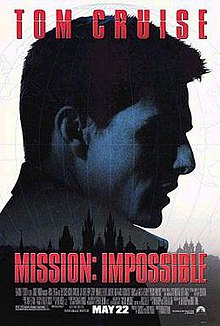
Thomas Cruise Mapother IV is an American actor and producer. Regarded as a Hollywood icon, he has received various accolades, including an Honorary Palme d'Or and three Golden Globe Awards, in addition to nominations for four Academy Awards. His films have grossed over $4 billion in North America and over $11.5 billion worldwide, making him one of the highest-grossing box-office stars of all time. He is consistently one of the world's highest-paid actors.

Mission: Impossible is an American espionage television series that aired on CBS from September 1966 to March 1973. It was revived in 1988 for two seasons on ABC. It also inspired the series of theatrical motion pictures starring Tom Cruise beginning in 1996.

Robert Towne is an American screenwriter and director. He started with writing films for Roger Corman including The Tomb of Ligeia (1964). Later, he was a part of the New Hollywood wave of filmmaking. He wrote the Academy Award-winning original screenplay for Roman Polanski's Chinatown (1974), which is widely considered one of the greatest screenplays. Towne also wrote the sequel, The Two Jakes (1990), and the Hal Ashby comedy-dramas The Last Detail (1973) and Shampoo (1975). He has collaborated with Tom Cruise on the films Days of Thunder (1990), The Firm (1993) and the first two installments of Mission: Impossible franchise.
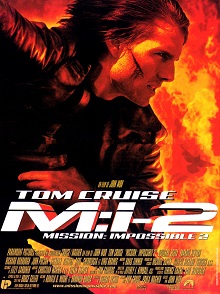
Mission: Impossible 2 is a 2000 action spy film directed by John Woo and produced by and starring Tom Cruise. It is the sequel to Mission: Impossible (1996) and the second installment in the Mission: Impossible film series. The film also stars Dougray Scott, Thandiwe Newton, Richard Roxburgh, John Polson, Brendan Gleeson, Rade Šerbedžija and Ving Rhames. In the film, Ethan Hunt (Cruise) teams with professional thief Nyah Nordoff-Hall (Newton) to secure a genetically modified disease held by rogue Impossible Missions Force (IMF) agent Sean Ambrose (Scott), who is Nordoff-Hall's former lover.

David Koepp is an American screenwriter and director. He is the ninth most successful screenwriter of all time in terms of U.S. box office receipts with a total gross of over $2.3 billion. Koepp has achieved both critical and commercial success in a wide variety of genres: thriller, science fiction, comedy, action, drama, crime, superhero, horror, adventure, and fantasy.

Irving Rameses Rhames is an American actor. He is known for his roles as IMF Agent Luther Stickell in all Mission: Impossible films (1996–present) and gang kingpin Marsellus Wallace in Pulp Fiction (1994).
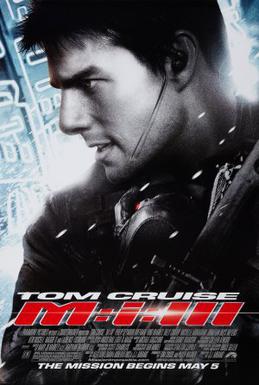
Mission: Impossible III is a 2006 American action spy film directed by J. J. Abrams and produced by and starring Tom Cruise, from a screenplay by Abrams and the writing team of Alex Kurtzman and Roberto Orci. It is the sequel to Mission: Impossible (1996) and Mission: Impossible 2 (2000) and the third installment in the Mission: Impossible film series. It also stars Philip Seymour Hoffman, Ving Rhames, Michelle Monaghan, Billy Crudup, Jonathan Rhys Meyers, Keri Russell, Maggie Q and Laurence Fishburne. In Mission: Impossible III, retired Impossible Mission Force (IMF) agent and trainer Ethan Hunt (Cruise) is forced to return to active duty to capture elusive arms dealer Owen Davian (Hoffman).

Mission: Impossible is an action-adventure video game developed by Infogrames and loosely based on the 1996 film of the same name. It was originally released for the Nintendo 64 video game console in 1998. In the game, the player assumes the role of Ethan Hunt, an Impossible Missions Force (IMF) agent who must clear his name after a mole has infiltrated the IMF team. The game features 20 levels where the player must complete several mission objectives with the use of numerous high-tech gadgets.
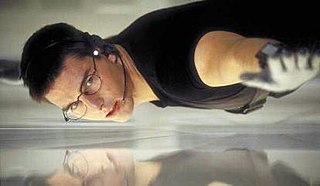
Ethan Matthew Hunt is a fictional character and the protagonist of the Mission: Impossible film series. He is portrayed by Tom Cruise. The character of Ethan Hunt is a highly skilled field agent and operative for the Impossible Mission Force (IMF), a secret government agency that handles dangerous and high-stakes missions.

Mission: Impossible – Operation Surma is an action-adventure stealth video game developed by Paradigm Entertainment and published by Atari for Game Boy Advance, Xbox, PlayStation 2 and GameCube. The game takes place between Mission: Impossible 2 and Mission: Impossible III.

Tom Cruise is an American actor and producer who made his film debut with a minor role in the 1981 romantic drama Endless Love. Two years later he made his breakthrough by starring in the romantic comedy Risky Business (1983), which garnered his first nomination for the Golden Globe Award for Best Actor – Motion Picture Musical or Comedy. In 1986, Cruise played a naval aviator in the Tony Scott-directed action drama Top Gun which was the highest-grossing film of the year, and also appeared with Paul Newman in the Martin Scorsese-directed drama The Color of Money. Two years later, he starred with Dustin Hoffman in the Academy Award for Best Picture-winning drama Rain Man (1988), and also appeared in the Golden Raspberry Award for Worst Picture-winning romantic drama Cocktail (1988). In doing so Cruise became the first and only person to star in a Best Picture Oscar winner and a Worst Picture Razzie winner in the same year. His next role was as anti-war activist Ron Kovic in the film adaptation of Kovic's memoir of the same name, Born on the Fourth of July (1989), for which he received the Golden Globe Award for Best Actor – Motion Picture Drama.

Mission: Impossible is an American television series that chronicles the missions of a team of secret American government agents known as the Impossible Missions Force (IMF). The show is a continuation of the 1966–1973 TV series of the same name. The only actor to return for the series as a regular cast member was Peter Graves who played Jim Phelps, although two other cast members from the original series returned as guest stars. The only other regular cast member (unseen) to return for every episode was the voice of "The Tape", Bob Johnson.

Luther Stickell is a fictional character in the Mission: Impossible film series who first appeared in the 1996 film Mission: Impossible and is the only character besides Ethan Hunt to appear in every film to date.
Mission: Impossible is a series of American action spy films, based on the 1966 TV series created by Bruce Geller. The series is mainly produced by and stars Tom Cruise, who plays Ethan Hunt, an agent of the Impossible Missions Force (IMF). The films have been directed, written, and scored by various filmmakers and crew, while incorporating musical themes from the original series by Lalo Schifrin.
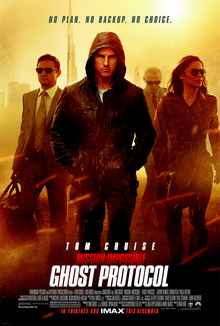
Mission: Impossible – Ghost Protocol is a 2011 American action spy film directed by Brad Bird from a screenplay by the writing team of Josh Appelbaum and André Nemec, who also serve as co-producers. Produced by Tom Cruise, J. J. Abrams, and Bryan Burk, it is the sequel to Mission: Impossible III (2006) and is the fourth installment in the Mission: Impossible film series. The film stars Cruise, Jeremy Renner, Simon Pegg, and Paula Patton, with Michael Nyqvist, Vladimir Mashkov, Josh Holloway, Anil Kapoor, and Léa Seydoux in supporting roles. In the film, the Impossible Missions Force (IMF) is shut down after being publicly implicated in a bombing of the Kremlin, causing Ethan Hunt (Cruise) and his team to go without resources or backup in a life-threatening effort to clear their names.

Mission: Impossible – Rogue Nation is a 2015 American action spy film written and directed by Christopher McQuarrie from a story by McQuarrie and Drew Pearce. It is the sequel to Mission: Impossible – Ghost Protocol (2011) and the fifth installment in the Mission: Impossible film series. It stars Tom Cruise in the main role, Jeremy Renner, Simon Pegg, Ving Rhames, Rebecca Ferguson, Sean Harris and Alec Baldwin. It follows Impossible Missions Force agent Ethan Hunt (Cruise) and his team, who, subsequent to their disbandment and Hunt's pursuit by the Central Intelligence Agency, must surreptitiously fight The Syndicate, an international black ops terrorist group of rogue government agents from around the world.

Mission: Impossible – Fallout is a 2018 American action spy film written and directed by Christopher McQuarrie. The sequel to Mission: Impossible – Rogue Nation (2015), it is the sixth installment in the Mission: Impossible film series. The ensemble cast comprises Tom Cruise, Henry Cavill, Ving Rhames, Simon Pegg, Rebecca Ferguson, Sean Harris, Angela Bassett, Vanessa Kirby, Michelle Monaghan, and Alec Baldwin. Set two years after the events of Rogue Nation, Fallout follows Impossible Missions Force agent Ethan Hunt (Cruise) and his team in their efforts to prevent a nuclear attack by terrorist Solomon Lane and the mysterious extremist John Lark.

Mission: Impossible – Dead Reckoning Part One is a 2023 American spy action film directed by Christopher McQuarrie from a screenplay he co-wrote with Erik Jendresen. It is the sequel to Mission: Impossible – Fallout (2018) and the seventh installment in the Mission: Impossible film series. It stars Tom Cruise as Ethan Hunt, alongside an ensemble cast including Hayley Atwell, Ving Rhames, Simon Pegg, Rebecca Ferguson, Vanessa Kirby, Esai Morales, Pom Klementieff, Mariela Garriga, and Henry Czerny. In the film, Hunt and his IMF team face off against "the Entity", a powerful rogue AI.
The untitled eighth Mission: Impossible film is an upcoming American spy action film directed by Christopher McQuarrie from a screenplay he co-wrote with Erik Jendresen. It is the direct sequel to Mission: Impossible – Dead Reckoning Part One (2023) and the eighth installment in the Mission: Impossible film series. Tom Cruise returns in his eighth appearance as the series' lead character, Ethan Hunt, whom he will have portrayed over a period of 29 years at the time of the film's release. Ving Rhames, Henry Czerny, Simon Pegg, Vanessa Kirby, Esai Morales, Hayley Atwell, Shea Whigham, and Pom Klementieff all reprise their roles from previous films in the series.
